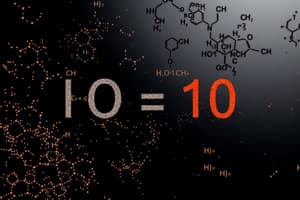Podcast
Questions and Answers
What is the definition of oxidation in terms of electron transfer?
What is the definition of oxidation in terms of electron transfer?
- Loss of electrons (correct)
- Gain of electrons
- Gain of neutrons
- Loss of protons
Which species acts as the oxidizing agent in the given reaction involving Cd and NO3?
Which species acts as the oxidizing agent in the given reaction involving Cd and NO3?
- NO~3~^- (correct)
- H~2~O
- H^+
- Cd
In the reaction 8Al + 3Fe3O4 → 4Al2O3 + 9Fe, which element is being reduced?
In the reaction 8Al + 3Fe3O4 → 4Al2O3 + 9Fe, which element is being reduced?
- O
- Alloy
- Al
- Fe (correct)
What is the change in oxidation number for aluminum (Al) in the reaction 8Al + 3Fe3O4 → 4Al2O3 + 9Fe?
What is the change in oxidation number for aluminum (Al) in the reaction 8Al + 3Fe3O4 → 4Al2O3 + 9Fe?
How many molecules of water are produced in the balanced equation 3Cd + 8H^+ + 2NO3 → 3Cd^2+ + 2NO + 4H2O?
How many molecules of water are produced in the balanced equation 3Cd + 8H^+ + 2NO3 → 3Cd^2+ + 2NO + 4H2O?
What occurs during the oxidation of an element?
What occurs during the oxidation of an element?
In the redox reaction Zn + Cu^2+ → Zn^2+ + Cu, what is the role of zinc?
In the redox reaction Zn + Cu^2+ → Zn^2+ + Cu, what is the role of zinc?
In the reaction 2Na + Cl2 → 2Na^+ + Cl^-, what happens to the sodium atoms?
In the reaction 2Na + Cl2 → 2Na^+ + Cl^-, what happens to the sodium atoms?
Which statement correctly describes an oxidising agent?
Which statement correctly describes an oxidising agent?
What does an oxidation number of zero indicate?
What does an oxidation number of zero indicate?
When chlorine is added to water to kill germs, what role does Cl2 play?
When chlorine is added to water to kill germs, what role does Cl2 play?
What characterizes a reducing agent in a chemical reaction?
What characterizes a reducing agent in a chemical reaction?
In the context of oxidation and reduction, what does the acronym OILRIG stand for?
In the context of oxidation and reduction, what does the acronym OILRIG stand for?
What is the oxidation number of the nitrogen atom in the NO3^- ion?
What is the oxidation number of the nitrogen atom in the NO3^- ion?
What is the oxidation number of sulfur in Na2S2O3?
What is the oxidation number of sulfur in Na2S2O3?
In which situation does the oxidation number of hydrogen become -1?
In which situation does the oxidation number of hydrogen become -1?
Which of the following statements about oxidation numbers is NOT correct?
Which of the following statements about oxidation numbers is NOT correct?
What is the overall charge on the complex ion if the sum of the oxidation numbers equals +3?
What is the overall charge on the complex ion if the sum of the oxidation numbers equals +3?
What is the oxidation number for oxygen in most of its compounds?
What is the oxidation number for oxygen in most of its compounds?
When a species is reduced, what happens to its oxidation number?
When a species is reduced, what happens to its oxidation number?
Which of the following elements can have an oxidation number higher than +1?
Which of the following elements can have an oxidation number higher than +1?
In the reaction Cu + 2H2SO4 → CuSO4 + SO2 + 2H2O, which element is oxidized?
In the reaction Cu + 2H2SO4 → CuSO4 + SO2 + 2H2O, which element is oxidized?
What is the role of sulfuric acid in the provided reaction?
What is the role of sulfuric acid in the provided reaction?
What color does potassium bromide solution turn after the addition of chlorine water?
What color does potassium bromide solution turn after the addition of chlorine water?
Which halogen is the strongest oxidizing agent based on the displacement reactions observed?
Which halogen is the strongest oxidizing agent based on the displacement reactions observed?
What observation indicates the presence of sulfate ions in the sodium sulfite and chlorine reaction?
What observation indicates the presence of sulfate ions in the sodium sulfite and chlorine reaction?
What happens to potassium iodide when chlorine water is added?
What happens to potassium iodide when chlorine water is added?
In the reaction between bromine water and potassium iodide, what is the product formed?
In the reaction between bromine water and potassium iodide, what is the product formed?
Which statement is true regarding the oxidizing ability of halogens?
Which statement is true regarding the oxidizing ability of halogens?
What type of reaction occurs when zinc is added to copper sulfate solution?
What type of reaction occurs when zinc is added to copper sulfate solution?
What confirms the presence of Fe3+ ions when dilute sodium hydroxide solution is added?
What confirms the presence of Fe3+ ions when dilute sodium hydroxide solution is added?
Which half-equation represents the oxidation of iron(II) ions?
Which half-equation represents the oxidation of iron(II) ions?
What happens to the color of the copper sulfate solution when magnesium ribbon is placed in it?
What happens to the color of the copper sulfate solution when magnesium ribbon is placed in it?
Which oxidation state change occurs for manganese in the redox reaction with Fe^2+?
Which oxidation state change occurs for manganese in the redox reaction with Fe^2+?
When chlorine water is added to iron(II) sulfate, what noticeable change occurs?
When chlorine water is added to iron(II) sulfate, what noticeable change occurs?
How are the electrons balanced in the oxidation and reduction half-equations?
How are the electrons balanced in the oxidation and reduction half-equations?
What type of reaction is observed with magnesium and copper sulfate when magnesium displaces copper?
What type of reaction is observed with magnesium and copper sulfate when magnesium displaces copper?
Flashcards
Oxidation
Oxidation
Loss of electrons by an element.
Reduction
Reduction
Gain of electrons by an element.
Redox Reaction
Redox Reaction
A reaction where both oxidation and reduction occur simultaneously.
Oxidising Agent
Oxidising Agent
Signup and view all the flashcards
Reducing Agent
Reducing Agent
Signup and view all the flashcards
Oxidation Number
Oxidation Number
Signup and view all the flashcards
Uncombined Element Oxidation Number
Uncombined Element Oxidation Number
Signup and view all the flashcards
Redox reaction example
Redox reaction example
Signup and view all the flashcards
Oxidation number of an ion
Oxidation number of an ion
Signup and view all the flashcards
Oxidation number of oxygen
Oxidation number of oxygen
Signup and view all the flashcards
Oxidation number of hydrogen
Oxidation number of hydrogen
Signup and view all the flashcards
Oxidation number of halogens
Oxidation number of halogens
Signup and view all the flashcards
Oxidation number rule (compounds)
Oxidation number rule (compounds)
Signup and view all the flashcards
Oxidation number rule (complex ions)
Oxidation number rule (complex ions)
Signup and view all the flashcards
Oxidation Number Change
Oxidation Number Change
Signup and view all the flashcards
Halogen Displacement Reaction
Halogen Displacement Reaction
Signup and view all the flashcards
Chlorine as an Oxidizing Agent
Chlorine as an Oxidizing Agent
Signup and view all the flashcards
Bromine as an Oxidizing Agent
Bromine as an Oxidizing Agent
Signup and view all the flashcards
Sulfite Oxidation by Chlorine
Sulfite Oxidation by Chlorine
Signup and view all the flashcards
Barium Sulfate Precipitate
Barium Sulfate Precipitate
Signup and view all the flashcards
What is oxidation in terms of oxidation number?
What is oxidation in terms of oxidation number?
Signup and view all the flashcards
Identify the oxidising agent
Identify the oxidising agent
Signup and view all the flashcards
Identify the reducing agent
Identify the reducing agent
Signup and view all the flashcards
What does it mean to balance a redox reaction?
What does it mean to balance a redox reaction?
Signup and view all the flashcards
How are redox reactions used in welding?
How are redox reactions used in welding?
Signup and view all the flashcards
Greenish-brown precipitate
Greenish-brown precipitate
Signup and view all the flashcards
Oxidation of Fe²⁺
Oxidation of Fe²⁺
Signup and view all the flashcards
Reduction of Cl₂
Reduction of Cl₂
Signup and view all the flashcards
Displacement Reaction
Displacement Reaction
Signup and view all the flashcards
Zinc and Copper Sulfate
Zinc and Copper Sulfate
Signup and view all the flashcards
Magnesium and Copper Sulfate
Magnesium and Copper Sulfate
Signup and view all the flashcards
Balancing Redox Equations (Step 1)
Balancing Redox Equations (Step 1)
Signup and view all the flashcards
Balancing Redox Equations (Step 2)
Balancing Redox Equations (Step 2)
Signup and view all the flashcards
Study Notes
Oxidation and Reduction
- Oxidation is the loss of electrons.
- Reduction is the gain of electrons.
- OILRIG (Oxidation Is Loss, Reduction Is Gain)
- Oxidation and reduction always occur together.
- Substances that cause oxidation in other substances are oxidizing agents.
- Substances that cause reduction in other substances are reducing agents.
- Oxidizing agents are always reduced.
- Reducing agents are always oxidized.
- Chlorine is an oxidizing agent, used for disinfecting water.
Oxidation Numbers
- Oxidation number is the charge an atom has when electrons are distributed according to rules.
- Oxidation numbers are used to track electrons in chemical reactions, particularly covalent compounds.
- Uncombined elements have an oxidation number of zero.
- Ions have an oxidation number equal to their charge.
- Oxygen generally has an oxidation number of -2, except in peroxides and OF2.
- Hydrogen generally has an oxidation number of +1, except in metal hydrides where it's -1.
- Halogens usually have an oxidation number of -1, except when bonded to a more electronegative atom.
- The sum of oxidation numbers in a compound or complex ion equals the overall charge.
Oxidation and Reduction in Terms of Oxidation Numbers
- Oxidation involves an increase in oxidation number.
- Reduction involves a decrease in oxidation number.
- Example reactions (from the text) are given in which oxidation numbers change in reactions, showing oxidation and reduction.
- Copper is oxidized, becoming a reducing agent. Sulfuric acid is reduced.
- Chlorine is an oxidizing agent.
- Ions in the reaction of chlorine, bromine and iodine are oxidized.
- Zinc is a reducing agent, oxidising copper ion.
Displacement Reactions of Metals
- Zinc displaces copper from copper sulfate solution.
- Zinc loses electrons and is oxidized.
- Copper gains electrons and is reduced.
Balancing Redox Equations
- Steps are given to balance redox reactions.
- Examples given using manganese and iron.
Studying That Suits You
Use AI to generate personalized quizzes and flashcards to suit your learning preferences.
Related Documents
Description
This quiz explores the fundamental concepts of oxidation and reduction, including definitions and characteristics of oxidizing and reducing agents. It also examines the importance of oxidation numbers in chemical reactions. Test your understanding of these key chemistry principles!




